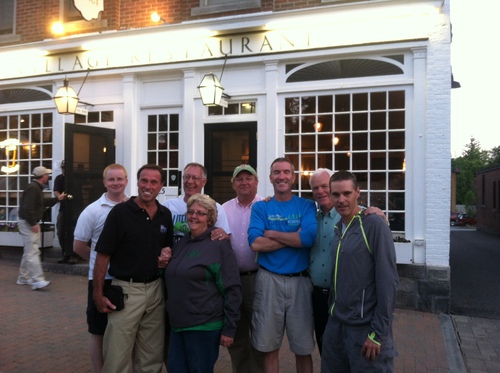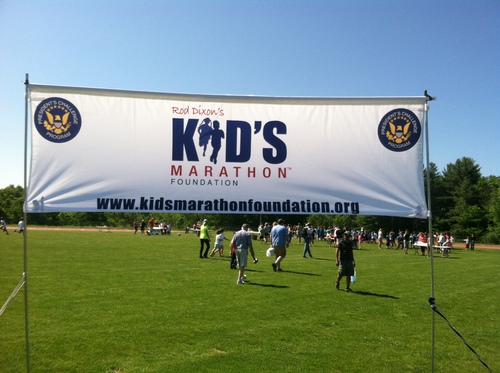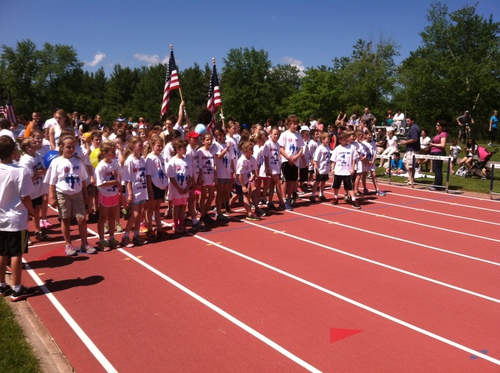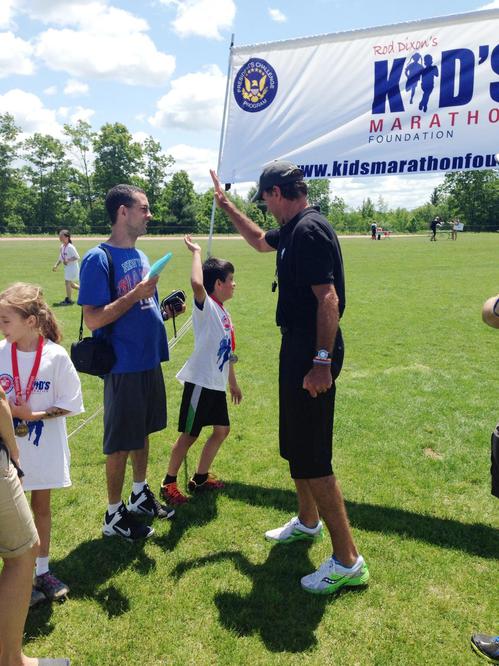RelatedPosts
A Grand Trip to a Big Race in a Small Town–The Litchfield Hills Road Race
by Jeff Benjamin
“If running was a religion, then Litchfield would be Christmas”–Brent “The Hawk” Hawkins
In his book, “Kings of the Road”, author Cameron Stracher writes of the running boom of the 1970s and it’s interesting growth in small unknown towns in America. Stracher also writes of how a strange, inexplicable combination of prize money (over and under the table!) and elite athletes intermingled with community involvement to create a carnival-like atmosphere of races in which the masses participated in huge numbers, thereby creating a “human flood” into the small town, which would last over a few days.
One of the events’ pride and joy-the Kids marathon
As the years have progressed now through a second running boom continuing into the new century, the small-town road race has sadly started to disappear in some parts of the country’s landscape. While the Falmouths and the Peachtrees still are thriving, other old familiar road races have faded away. There are probably many factors which explain this sad change. This past weekend (June 8), at the behest of New Zealand Olympic Bronze 1500 medalist and 1983 NYC Marathon champion Rod Dixon , I decided to venture to one of those original, 1970s road races which takes place the first week in June since 1977 in the small town of Litchfield, Connecticut. What I found was not only the that strange mix of factors previously written by Stracher, but also new ingredients which probably should be added to the mixture towards putting on successful running events in the small towns of 21st century America. Here is my journey;
Friday, June 6th
I arrived later in the day in Litchfield and called my town contact Litchfield Hills Road Race President Beth Murphy who proceeded to give me direction to “Runners Park”. First though I had to eat. Beth recommended me to eat in the Village, a bar/restaurant which also serves as the race hub. On the walls were classic photos from the earlier Litchfield races.
Framed on the wall were classic retro pictures of former champions Bill Rodgers (Who won the first Litchfield Race in 1977), Patti Catalano, Joan Benoit, and town favorite, Bob Hodge, who will be showing up again to run on Sunday!! It was here that one of the founders of the race, Billy Neller, introduced himself to me and gave me directions to “Runners Park”. When I arrived there were assembled a few people in a small garden located on the side of the road. The garden was sprinkled with plastic flamingoes which have become the mascots for the race.
Rod Dixon and Jeff Benjamin
It was here that Beth and others told me of the beginnings of the race, which was the brainchild of the late Joe Concannon, a great runner and the author of one of Bill Rodgers’ earliest biography “Marathoning”. Concannon was heavily influenced by the Falmouth Race so, in 1977, with the help of the community and his right hand man Billy Neller, he formed his own 7.1 road race through this small town and proceeded to invite and reward some of America’s and the world’s best runners to come down and compete in this race. The LHRR has seen runners from Ireland, New Zealand, Kenya, Great Britain, Belgium, Tanzania, Canada, Yugoslavia, Morocco and Poland throughout the years, making the fields quite competitive. I was then shown these two small square flat concrete monuments embedded into the ground. These were put there in memory of Roberta Coffill Healy and George Dwan.They were race marshals from the race’s inception in 1977 and had worked right on this very location. Dwan passed away in 2008, Roberta Coffill Healy this past February. Her husband Jack still marshals the race. With his friend Coffill-Haly, it was Dwan who would decorate the area with pink flamingos, silver Christmas trees, pinwheels, and other tacky trinkets, hence the traditions.
I was then given a car tour of the course. A series of flat areas, intermixed with rolling hills, the course then passed just before the 6 mile mark. There I saw the Litchfield cemetery, where I was then invited to an annual tradition which would take place the next day in the afternoon: the graveyard tribute. Once we passed the cemetery, we approached the 6 mile mark on Gallows Lane, coming to a stretch of a hill which lasted about 400 yards. The Gallows Lane Hill has been rated one of the toughest road race hills in the world by Runners World magazine. The stories of Bill Rodgers reaching for a “9th gear” when he raced on this monster resonates with the townspeople to this day. On Sunday, the 1600 participants (including myself) will find out for ourselves.
It was then that I was brought to my friend Rod Dixon, who then proceeded to take me to the house of my hosts, the Burgess family. My long day had finally ended.
Kids Marathon
Saturday, June 7th
“This is for YOU today,” Rod Dixon tells his very special guests this Saturday morning at the local school track in Plumb Hill Fields. “Short cuts are dead ends. Finishing is winning and winning is finishing!!” Its a good thing that Rodney had an exceptional speaker system. The outgoing New Zealander was addressing over 600 schoolchildren from 13 schools in the Litchfield area.
The day before the big road race, a newer tradition, one that had begun in 2007 had sprung up in Litchfield ; the culmination of the Rod Dixon’s Kid’s Marathon Program. Designed for kids ages 7 through 12, Dixon’s mantra is to encourage kids to get in shape. Approved by the Connecticut Association of Schools, the kids participate in a program of running different distances over a period of time so that by the time June 7th rolls around, they have to complete 1 mile with Dixon supervising to finishing their total mileage at the marathon distance–26.2 miles!! And what a grand way to finish it. With DJ music, balloons and a performance by Forbes Flyers Rope Performers, friends and parents sitting in the stands can cheer and applaud their kids as they complete the last mile!
Of course some kids went out like maniacs and slowed down very dramatically. Some of them paced themselves quite well, while other walked. But it didn’t matter. They had completed the program! Every kid received a medal from Dixon, who then took a group photo with each of the school’s programs and then must have set a world record that day for signing the back of over 600 eager kids’ t-shirts in record time!”Litchfield is our 3rd largest event in the state behind Danville and Waterbury,” said Dixon.
Announcing most of the program was someone who I had heard of throughout the sport of road racing in America–“The HAWK”, aka Brent Hawkins. Everyone who I had mentioned my Litchfield trip to all said to say hello to the Hawk, among them Bill Rodgers and Tom Fleming!
A real good runner from the 1970-80 boom years, the Hawk relayed to me how he was sitting on a ferry after the Falmouth race back in 1985 and how he was invited by Joe Concannon from his town of Union Town, Pennsylvania, to Litchfield. He never went back. “I totally fell in love with this place,” he said through the brim of his own unique-flamingo decorated style hat. For many years, the man who has known every elite runner ever to come here serves as the race announcer for the road race as well.
But it was also the Hawk who also corralled Dixon to come to Litchfield in 2007 to speak at a clinic. “He’s the father of the Kid’s Marathon”, Dixon said. “It was through him that I was introduced to Bill Burgess, who is now like family to me, and helped me launch our program and this program is creating in the kids the idea that they can run the 7 miler one day in their future too!” The President and the Chief Executive of Litchfield Hills Food, Inc., Bill, who has involved himself through the years in many non-profit ventures, also serves as the Chairman of Dixon’s Marathon Foundation.
Later on at 2PM was the Cemetery tour, which is a town tradition. Part solemn and part humorous, the approximately 200 people in attendance heard tributes that were given by the members of the race committee in honor of those who were associated with the race who had passed on. Bagpipes were played during the ceremony. The final culmination was the tribute given to race founder Joe Concannon, who passed away suddenly from a heart attack in 2000, by Billy Neller, along with the Hawk. The tribute then concluded with guitarist Ian Campbell singing his rendition of his tune, “The Litchfield Hills road Race” along with a special tribute to the victims of the 2013 Boston Marathon. It was at the conclusion of the event that I came across Patricia Owens. Ms Owens had been a mainstay elite athlete coordinator under the late Fred Lebow and Allen Steinfeld in the New York Road Runners club. Nowadays, she’s the person in charge of handling the press for Litchfield. “This is truly a great event, which caters to all kinds of runners,” she said.
After this great event, it was off to lunch at the Village, where I encountered Bobby Hodge. Known as “Hodgie-San”, this Greater Boston Track Club staple was one of those runners right behind the Rodgers and Shorters of the era, known for winning here at Litchfield as well as sporting a Marathon PB of 2:10:59 and finishing third in the 1979 Boston Marathon, just behind the epic fight between Rodgers and Toshihiko Seko. “I come back to Litchfield often,” said Hodge, who hopes to hold an 8:30 pace tomorrow. We talked about many things, from his 1987 World Cross-Country performance representing the U.S., to “The Rookie”–Alberto Salazar.
“I knew Alberto’s brother, and when Alberto joined Greater Boston as a skinny kid, he had an incredible drive and desire back then, more so than us, and we were pretty intense.” Like many, Hodge reached out to Salazar after his heart attack 6 years ago, where his heart stopped for 14 minutes. “It is truly remarkable he came back,” he said. Hodge then sent Tom
Fleming the following text message via my cellphone, “time for your medicine!!” Hodge recalled training in Florida with Rodgers, Fleming and others. “I hated training early in the morning, and around 7 am these guys would be knocking on my door shouting, “Hey Hodgie! Time for your medicine!” We had great cameraderie back then.”
After being regaled by Hodgie-San stories, I then spent the rest of the night with Rodney at the Burgess home. “Here’s a little brew I made up for you mate,try it,” said Dixon. I was a little apprehensive at first. This was the legendary New Zealander Rod Dixon, who was known through the years to be one of those party and drinking-types from the European and Road Race circuit , to say the least. Thinking it was a brew mixing in some Fosters’ ale, I proceeded to drink this concoction and felt a hot rush through the back of my throat when I was done.
“Oh, that’s probably the Ginger”, he said. It was an all-natural drink, with natural antioxidants. Which then led me to talk with him about his changes in his life. After trying to break sub-4 for the masters mile in the early 1990s (He did run an incredible 4:02 on the old Madison Square Garden 11 laps to the mile – wood track at the 1990 Millrose Games!) Dixon by 2002 had pretty much retired and was living his life on a 260-acre farm in New Zealand. Never one to worry about his health, he was shocked to learn from his doctor that he was on the verge of having severe health problems, and quite possibly a heart attack if he kept up his unhealthy lifestyle. “There were two choices for me. I could either go on meds for the rest of my life where there would be instant results, but side-effects later on, or I could change my diet and lifestyle which would take a lot more discipline, a lot more time before I felt better, but with no side-effects. I chose the second choice, and I’ve never looked back.”
For a man in his 60s’ Dixon looks like a young 40. But he wasn’t finished. “I felt I had more to offer.” In 1972, the newly minted Olympic Bronze 1500 medalsit presented himself to Sir Edmund Hillary. The first man to conquer Mount Everest complimented him and told Dixon to do more with his life. 29 years later, he took Hillary’s advice. He left his farm and re-entered the world with his philosophy and hope for helping young people. “Childhood obesity is something we can fight, and exercise and wise food choices have to be shown the kids and their parents, which is why I started this Marathon Kid’s program. I’m also blessed to have the support of Bill Burgess and others was well.” He then told the story of how, around 2002, when he was strating his program for New Zealand youth, he recieved a phone call and was invited again to visit with Sir Edmund. “I thought I was in trouble, but he told me how he rembered what he said to me back then and how he would be willing to help me. Sir Edmund’s support opened lots of doors for me, and I’m very grateful for that.”
We then harkened back to the track and road race circuits of the ’70s and 80s, his Olympic performances in 1972 and 1976, and his relationship with fellow countryman, the legendary John Walker. “We were and always will be, best mates,” he said. Traveling together through the years on the track circuit, Dixon spoke of how he handled more of the business side for the two of them when dealing with meet promoters, but that Walker always covered equal expenses with him every time.
There were other interesting anecdotes as well, like in 1975 when Walker became the first person to break 3:50 for the mile. “It was one of the very few times that he didn’t want me in the race, so he could focus more. I still believe to this day that if I was in the race, I would have run 3:49 too, and John would have run 3:48 if I was in that race that night.” In their relations with the great British milers, their paths diverged as well. “I was more close with Seb Coe, while John liked to hang out with Ovett, but none of that affected our relationship with each other.” They also raced often.
“There was the time when we met Sir Roger Bannister, and he asked John about his races, and John told him how he ran 8 races in 7 days and broke 4 minutes in everyone of them. Sir Roger was astounded! He just couldn’t believe it!” Sadly, Walker is in the battle of his life today, as he is suffering from Parkinson’s disease. “we are really like brothers,” said Dixon.
The 1980 New Zealand boycott of the Olympic Games in Moscow pretty much ended Dixon’s track career, but it was NOT the end of his racing. “I was in America when the boycott was announced. I turned to road racing.” It was on the race circuit that Dixon, who was then based in Pennsylvania, dominated. “I believe in ’82 I ran close to 40 road races and won most of them.” His greatest victory on the roads was his dramatic, come-from-behind victory in the 1983 New York Marathon. But soon after, he injured himself in a motorcycle accident, “which set me back 4 months in training for the LA Olympics (1984).”
Dixon finished in 12th in the hot and humid race. Finally was there any advice from the man whose incredible range includes a 3:33.9 1500, 3:53.6 mile, 13:17.27 5000 (Ranking him #1 in the world in 1975), 28:11 10,000, a 1:02:12 world best half-marathon and a 2:08:59 marathon? “Train easy on your easy days. I heard from a runner once how he ran his long run and mixed in fartlek, with tough hills and speedwork along with tempo. But where are the easy days to recover? On my long runs with my mates in New Zealand, the slowest club member would always lead the run. Many runners today just don’t know how to recover.”
Rod Dixon with Kids’ Marathon participants
Race Day-Sunday June 9th
Woke up this morning to a very noisy house, in that many other great runners had slept over, notably quite a few men and women from Terrence Mahon’s BAA club!
The race day festivities began with 2 kids races, the last one being 2.3 miles. A hot, but not humid 83 degrees greeted us at the starting line for the1PM start. With the Hawk announcing, the cannon was fired and off we went through a downhill first mile. After surviving the tough rolling hills along with easy fast downhills and flat areas with crowds and bands all along the course giving encouragement to the runners. We would need it, especially as I approached the hill on Gallows lane.
Beginning right at the 6 mile mark and going with through the 10K mark, this severe upgrade took me 2 minutes to get over it. I obviously had no Bill Rodgers 9th or 8th or 7th gear in me (Probably 25th gear!) but no one passed me either. After enduring another .8 on the way back to the finish, I was rewarded along with my fellow runners with a last steep downhill run to the finish, as i crossed the line in 47 minutes, 24 seconds. I then learned that the defending champions,Eliud Ngetich of Kenya and American Esther Erb won again, as Ngetich finished with a sprint over Ethiopian Allele Megersa in a time of 34:40, while Erb broke away from fellow American Stephanie Pezzullo at “The Hill” and won in 40:26.
Right after the I had recovered I came across Hodgie-San, who was icing the top of his foot. Sensing he was disappointed, I told him i hoped to see him here next year. “I’ll be there,” he said. Also finishing the race was the town’s First Selectman, Leo Paul Jr., whose title is synonymous with that of a mayor, and seemed to be EVERYWHERE at every event during the weekend. With crowds cheering, bands playing and the Hawk announcing the names of almost every finisher to cross the line, the Litchfield Race was finished and in the books.
Epilogue
On my journey home, I thought about this race and the direction it’s going in. Without a doubt, the crowds were huge and the competition fierce like always. but could Litchfield be another extinct American Road Race from the 1970s? I think not, and there’s a few reasons in my humble opinion.
Firstly, the tradtions such as the cemetery walk, the flamingoes, the runners’ park and the hanging out at the Village resturaunt seemed to me to be going as strong as ever. Also, the influx of Rod Dixon’s programs for kids on that Saturday morning bodes well for the growth of future runners participating in the Sunday race.
But most importantly, the Litchfield race committee is a group which is made up of the “old-timers” and the “young turks”. The race, started by Joe Concannon and Billy Neller, recruited (or “Shanghaied”) Beth Murphy in the late 1990s, and she plays a very prominent role. During the weekend I came across 30 year old fireman Sammy Kinkaid, who seems to be eager and willing to assume whatever future Litchfield mantles he may get, as he also seemed to everywhere at key events throughout the weekend.
Therein might lay the secret for keeping this race, or any other race going. As Cameron Stracher stated, the prize money, elite athletes along with that strange mixing of runners of all abilities by the thousands particpating have helped this tradition to keep going strong. But new ingredients such as remembrances, traditions, inclusiveness and willingness to share and delegate responsibilities to the next generation by the previous one could be a lesson which could and should be borrowed by many of these small towns which host big road races throughout the country and can keep them going on to success indefinitely.
PS–I am beyond grateful to the hospitality of Beth Murphy, her race committee and the Village Restaurant. I am also grateful for the new friendships made with Sammy Kinkaid, Allison Reilly.
The Hawk, Billy Neller, Leo Paul Jr. and Jack Healy among others.
My great thanks to the wonderful Burgess family for their welcoming me into their home and making me feel part of a truly grand adventure. Bill and Joan, along with their daughter Michele were wonderful hosts. So was their son Grant, and although he beat me by a minute in the race, I won’t hold it against him.
The greatest thanks of all to my friend Rod Dixon. Without Rodney, this trip never would have happen. Although having an Olympic Bronze medal, Rodney will always be a Gold Medalist to me and I hope to all the other people affected by his grace, charm and constant optimism in the most important race of all, the race of Life.
Author

Larry Eder has had a 52-year involvement in the sport of athletics. Larry has experienced the sport as an athlete, coach, magazine publisher, and now, journalist and blogger. His first article, on Don Bowden, America's first sub-4 minute miler, was published in RW in 1983. Larry has published several magazines on athletics, from American Athletics to the U.S. version of Spikes magazine. He currently manages the content and marketing development of the RunningNetwork, The Shoe Addicts, and RunBlogRun. Of RunBlogRun, his daily pilgrimage with the sport, Larry says: "I have to admit, I love traveling to far away meets, writing about the sport I love, and the athletes I respect, for my readers at runblogrun.com, the most of anything I have ever done, except, maybe running itself." Also does some updates for BBC Sports at key events, which he truly enjoys. Theme song: Greg Allman, " I'm no Angel."
View all posts























